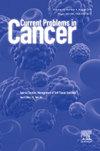Comparison of efficacy and toxicity of chemotherapeutic regimens used as adjuvant and/or neoadjuvant chemotherapy in penile cancer patients
IF 2.3
4区 医学
Q3 ONCOLOGY
引用次数: 0
Abstract
Objective
To compare the efficacy and toxicity of different chemotherapeutic regimens used as adjuvant or neoadjuvant chemotherapy in penile cancer patients.
Methodology
This observational study was carried out at Mahavir Cancer Sansthan & Research Centre (MCSRC), Patna, involving 112 patients who received various chemotherapy regimens: 5-Fluorouracil with Cisplatin (FP), Paclitaxel with Carboplatin (TP1), Paclitaxel with Cisplatin (TP2), and Paclitaxel with Ifosfamide and Cisplatin (TIP). Efficacy was assessed based on tumor response after Neoadjuvant Chemotherapy (NACT) using RECIST v1.1, and Disease-Free Survival (DFS) was calculated with the Kaplan-Meier method. Chemotherapy toxicity was evaluated using CTCAE v4.03, and statistical analysis was performed with SPSS v22.
Results
The mean age of the penile cancer patients was found to be 53.5 years. The most of the patients comes under stage-IIIb (62 patients – 55.4%). Out of 88 FP received patients, 28 were treated with NACT in which 24 had partial response (PR) and 4 had progressive disease (PD). The objective response rate (ORR) for this group was found to be 85.71%. Out of 21 TP1 received patients, 9 were treated with NACT in which 6 had CR and 3 had PR, therefore ORR was found to be 100%. Only one Patient received TIP as NACT had PR. The median DFS rate was found to be 6 months for ACT and 7 months for NACT in FP chemotherapy, whereas 10 months was found to be for ACT and NACT of TP1 combinations. The patients received TP1 combinations, had more than 6 months of DFS rate. The grade I-III haematological toxicity of anaemia, lymphocytopenia and thrombocytopenia was observed more in FP than TP1 and TP2 combinations. The grade I-III non-haematological toxicity was showed for all chemotherapy combinations.
Conclusion
Overall, the TP1 regimen stands out as the most effective and well-tolerated chemotherapy regimen for penile cancer, demonstrating both superior survival outcomes and a more favourable toxicity profile compared to the FP regimen.
辅助和/或新辅助化疗方案在阴茎癌患者中的疗效和毒性比较。
目的:比较不同化疗方案作为辅助或新辅助化疗在阴茎癌患者中的疗效和毒性。方法:本观察性研究在巴特那Mahavir Cancer Sansthan & Research Centre (MCSRC)进行,纳入112例接受不同化疗方案的患者:5-氟尿嘧啶+顺铂(FP)、紫杉醇+卡铂(TP1)、紫杉醇+顺铂(TP2)、紫杉醇+异环磷酰胺+顺铂(TIP)。采用RECIST v1.1基于新辅助化疗(NACT)后肿瘤反应评估疗效,采用Kaplan-Meier法计算无病生存期(DFS)。化疗毒性评价采用CTCAE v4.03软件,统计学分析采用SPSS v22软件。结果:阴茎癌患者的平均年龄为53.5岁。大多数患者处于iiib期(62例- 55.4%)。在接受FP治疗的88例患者中,28例接受NACT治疗,其中24例部分缓解(PR), 4例进展性疾病(PD)。本组患者客观有效率(ORR)为85.71%。21例TP1患者中,9例接受NACT治疗,其中6例发生CR, 3例发生PR,因此ORR为100%。在FP化疗中,ACT和NACT的中位DFS分别为6个月和7个月,而TP1联合使用ACT和NACT的中位DFS为10个月。采用TP1联合治疗的患者,DFS均大于6个月。与TP1和TP2联合用药相比,FP组贫血、淋巴细胞减少和血小板减少的I-III级血液学毒性更高。所有化疗组合均显示I-III级非血液学毒性。结论:总的来说,TP1方案是治疗阴茎癌最有效和耐受性良好的化疗方案,与FP方案相比,TP1方案显示出更好的生存结果和更有利的毒性特征。
本文章由计算机程序翻译,如有差异,请以英文原文为准。
求助全文
约1分钟内获得全文
求助全文
来源期刊

Current Problems in Cancer
医学-肿瘤学
CiteScore
5.10
自引率
0.00%
发文量
71
审稿时长
15 days
期刊介绍:
Current Problems in Cancer seeks to promote and disseminate innovative, transformative, and impactful data on patient-oriented cancer research and clinical care. Specifically, the journal''s scope is focused on reporting the results of well-designed cancer studies that influence/alter practice or identify new directions in clinical cancer research. These studies can include novel therapeutic approaches, new strategies for early diagnosis, cancer clinical trials, and supportive care, among others. Papers that focus solely on laboratory-based or basic science research are discouraged. The journal''s format also allows, on occasion, for a multi-faceted overview of a single topic via a curated selection of review articles, while also offering articles that present dynamic material that influences the oncology field.
 求助内容:
求助内容: 应助结果提醒方式:
应助结果提醒方式:


